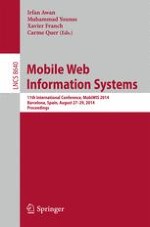This book constitutes the refereed proceedings of the 11th International Conference on Mobile Web and Information Systems, MobiWIS 2014, held in Barcelona, Spain, in August 2014. The 24 papers presented were carefully reviewed and selected from 75 submissions and cover topics such as: mobile software systems, middleware/SOA for mobile systems, context- and location-aware services, data management in the mobile web, mobile cloud services, mobile web of things, mobile web security, trust and privacy, mobile networks, protocols and applications, mobile commerce and business services, HCI in mobile applications, social media, and adaptive approaches for mobile computing.
